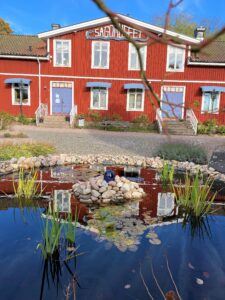Land of Legends – promote and revitalize storytelling
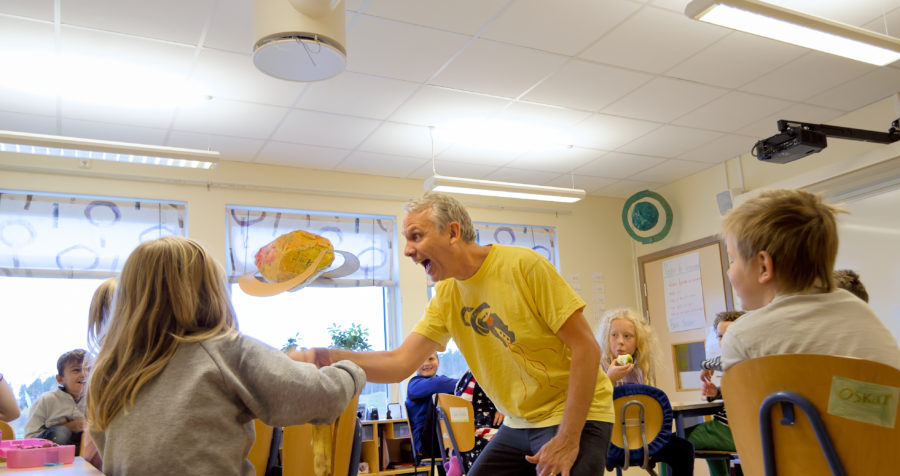
Background
Kronoberg region in southern Sweden has a long and strong storytelling tradition. In the late 1980’s a number of librarians and teachers in the region realized that the total loss of the tradition of storytelling was imminent. They – some of them experienced storytellers – first engaged in small-scale activities before they organized a festival (May 1990, Ljungby) in which practitioners, enthusiasts and experts from various places in Sweden participated. This was the start of the non-profit association that today runs the Land-Of-Legends (Sagobygden) based in the municipalities of Ljungby, Alvesta and Älmhult, a safeguarding program and practice that ever since have grown.
Above: The storyteller Mikael in a childrens classroom. Photo: Berätternätet Kronoberg
Objectives
The objectives of the programme are:
- Develop measures for revitalizing storytelling, initially in the Kronoberg region.
- Provide spaces for storytelling and listening.
- Explore new functions and ways of transmission for storytelling.
- Develop new venues and audiences.
- Cooperate regionally, nationally, and internationally with like-minded people, storytellers as well as experts.
- Be active in international projects where new collaborations and experience are shared.
- Preserve the value of storytelling for the well-being of the population at large.
- Inspire other organizations, companies and the like to use oral storytelling as a method.
- Raise awareness about the endangered viability of storytelling.
- Be an active participant in education from preschool to university
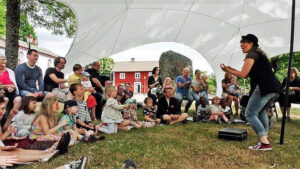
Storytelling to children. Photo: Berättarnätet Kronoberg.
How it was done
The association Berättarnätet Kronoberg (the Storytelling Network of Kronoberg), has been developing, testing, implementing and supervising a growing range of activities that have succeeded in raising the visibility of storytelling, in revitalizing its practice and in applying it in traditional and new venues.

Sagomuseet (the Museum of Legends) is situated in the South of Sweden. Photo: Agneta J-G
The following activities are part of the programme:
Storytelling Festival – transmission, training, sharing
From 1990 on, Ljungby Berättarfestival (the Ljungby Storytelling Festival) has been organized every summer, attended by storytellers, academic experts and story-lovers from the Kronoberg region, elsewhere in Sweden (including story-tellers from minority communities) and, increasingly, the Nordic Region. They come to perform and listen, to follow or give seminars and lectures about storytelling and safeguarding approaches, or workshops for training new storytellers. The Festival is an important forum for sharing approaches in renewing storytelling traditions.
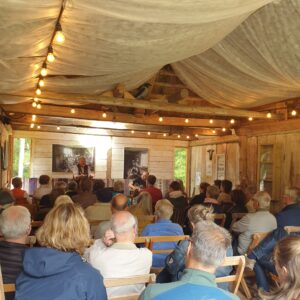
Venue from the Storytelling festival. Photo: Berättarnätet Kronoberg.
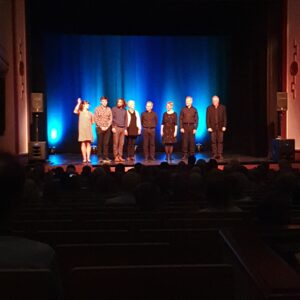
From the Storytelling festival. Photo: Berättarnätet Kronoberg.
Promoting the tradition among the local population
Some 80 legendary places linked to specific stories are documented and marked in Sagobygden, 40 of them by wooden story cabinets.
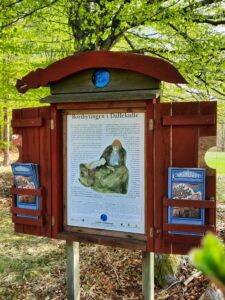
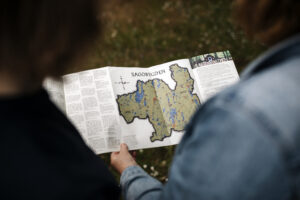
The story cabinets. Photo: Berättarnätet Kronoberg/Alexander Hall
You may find them by using a special map or geocaching. You can also use Google; write Sagobygden and all the names of the cabinets will appear. When you open a cabinet, you read local legends or listen to them using dedicated apps. All the stories, regardless of how you choose to read or listen to them, are available in three languages, Swedish, German and English.
Every summer storytelling is regularly practiced around the cabinets, often accompanied by traditional Music.
All year long storytelling activities are organized throughout Sagobygden, in cafés, in schools and at business events, to reinforce the place of storytelling in local society and for entertainment.
Activities in schools and in academia
The activities are aimed at raising awareness about storytelling, and at transmitting the art. Usually schools and universities invite and pay for staff.
- Methods and materials are developed for using storytelling.
- Inspire people of all ages to develop their own storytelling.
- All the activities are based on current policy documents and are updated continuously.
- To strengthen everyone based on their needs and prioritize children and students
- Communicative ability and language development (i.e. reading, writing, and speaking skills.)
- The stories and exercises that we work with can be about important things in different ways topics such as democracy, equality, respect.
The Association contributes to academic courses for future teachers who intend to use storytelling in their primary and secondary school teaching.
The Museum of legends
The museum is based on the rich treasure of fairy tales and legends that have been told and are still being told in Sagobygden.
The museum is created with a magical atmosphere and great beauty, by members of the NGO, artist and in close cooperation with the municipality and authorities in the region. It is created to be an accessible environment where the visitor dares to ask, please tell me a story!
You can walk around the museum on your own or experience it together with a storytelling guide who brings the stories portrayed to life.
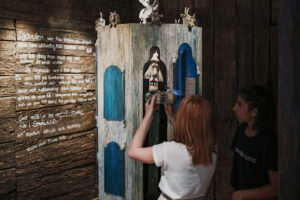
Magical stories at the museum Photo: Alexander Hall
Remedial activities
The Association has developed methods and textbooks for storytellers and staff of schools. as inspiration in teaching
Methods has been created as inspirations for staff in retirement home, assisting people affected by dementia. Similarly, methods were tested, and materials created for working, in their own environment, with mentally challenged people.
To break isolation for people over 65, material was developed for life story groups. Here, members of the group share memories and experiences with each other in a structured way.
In 2005, when a devastating storm hit southern Sweden, in particular Sagobygden, the forest fell, and many lives changed radically. The Association launched an appeal: “Talk, write, and paint about the storm”. The many responses resulted in a publication, a CD, radio programs and storytelling performances.
Sagobygden is constantly developing through various projects. Contemporary stories are collected via storytelling cafes. Experience around storytelling and its various uses is shared between associations and countries that see storytelling as a tool in working with people, tourism, and the preservation of a cultural heritage. It is important for the Storytelling Network of Kronoberg to constantly find new collaboration partners and seek funds to implement new projects.
Key factors
1. A storytelling festival
The festival is a mixture of other ICH manifestations (music), seminars and workshops. A combination of local storytellers and international guests enrich the event.
2. Volunteers
Volunteers play a crucial role. They represent different kind of groups, thus enriching the diversity of the activities.
3. Steady support
Steady support among the local population and authorities in three contiguous municipalities of the Kronoberg region: Ljungby, Älmhult and Alvesta, which have become known under the name Sagobygden. Everyone, no matter if you are a local resident or the major, you should feel involved in Sagobygden.
4. Working in schools
A close collaboration with teachers and schools is of great importance. We have teachers, pupils, sometimes researchers, doing evaluations. Our goal is to help the schools in there ordinary work. We pay extra attention to the school curriculum, so it fits together. We offer educational programs from 8 months up to university courses.
5. Sagomuseet
The museum opened in 1999 and was soon to become the centre of Sagobygden. It is today a popular place for tourists, visiting groups, for school children, for different kind of storytelling events and activites but also “a home” for many storytellers, to meet and exchange experiences and of course for the staff with its offices.
6. Running the legendary places in the landscape.
Local legends are highlighted especially in the landscape. These places are always open, to anyone, no admission fee, they can be read and listened to anytime of the day. We experience they are highly appriciated and locals are proud of living next to a legendary place.
7. Movable
The stories are inside the storyteller. We travel a lot to share stories both national and international. When working with intangible cultural heritage, it is easy to move around and work elsewhere.
8. Special needs in the society
The Association run several projects targeting groups of people in the scope of special needs. Some examples are:
a) Integrating projects, using stories to connect diversities of people, to highlight that we often share the same stories/ICH.
b) Program for those with dementia – we have an increasing population with dementia. Their memories can be activated by storytelling
c) Programs to break isolation, material has been developed for life story groups. Here, members of the group share memories and experiences with each other in a structured way.

